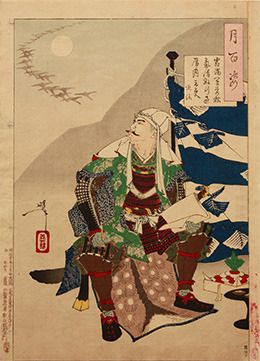Some of Nobunaga's enemies gained their fame exactly because they strongly opposed Nobunaga, but it wasn't always the case and the look of things changed in due time.
I would love to focus this first post on the subject on two of the characters that were most famous for their active partecipation to the so-called Anti-Nobunaga Alliance (信長包囲網, "Nobunaga Encirclement"), Takeda Shingen and Uesugi Kenshin.


Once Nobunaga put Yoshiaki back in Kyoto as the legitimate shogun, before the things got sour between the two, Yoshiaki worked quite hard to keep the land peaceful. To do so, he tried to solve peacefully the increasing tension between the more prominent daimyo of the time, supporting the collaborative relationships among the most "touchy" clans.
To do so, he used Nobunaga and his most beloved Asakura Yoshikage to promote diplomatic relationships between the Takeda, the Hojo and the Uesugi, and used Shingen to pacify Nobunaga and Kennyo.
Nobunaga started his correspondence with Ashikaga around 1565, discussing the matter of giving Ashikaga "back" his seat as shogun in Kyoto as a mean to stop the wars the scorched the lands of Japan.
It's mentioned that at first Ashikaga was keener on Kenshin as a supporter, but the continuous battles with his neighbour Shingen proved to keep him busy on the most important time, making him lose momento.
"Momento" which was caught by Nobunaga, who suddenly proved his worth as "saviour of the nation" by capturing Mino in 1567, entering the stage of "proper daimyo".
It's on the June of the same year that Nobunaga would start a serie of diplomatic marriages with the Takeda.
On 1565 Katsuyori, Shingen's heir, would take the daughter of a certain Toyama Naokado as his bride. Naokado was a vassal of Nobunaga, and his daughter was adopted by Nobunaga as his niece, thus making her an important pawn for diplomatic business.
Unfortunately the woman would die on 1567 due to childbirth. She would leave behind the unlucky son of Katsuyori, Nobukatsu, and a chance for another marriage, another unlucky one.
In 1567, in fact, the hand of the young Matsuhime was offered to Nobutada, both of them children fiancee. The marriage will never get to happen, though, because the relationship between Nobunaga and Shingen would turn inevitably sour on 1572-- But let's get in order.
The "march on Kyoto" that would grant the seat as shogun to Yoshiaki would happen in 1568.
With the mediation of Yoshiaki, Nobunaga would start a deep correspondence with the Uesugi clan via Naoe Kanetsugu around 1569.
So, one can assume that the situation among these great powers was relatively peaceful, at least 'til 1671, when the relationship between Yoshiaki and Nobunaga would break permanently: the two of them faced their first crisis on 1569, probably because in those days Nobunaga's attacked the Kitabatake clan of Ise without Yoshiaki's consent.
Around 1571 Shingen would show some intolerance to Nobunaga's methods related to the infamous Siege of Mount Hiei, where Nobunaga erased the warrior monks of Enryaku-ji.
As we said, on 1572 Shingen would break his peaceful relationship with Nobunaga.
Kenshin would last a few longer, even after Shingen's death on 1573, 'til 1576, joining the third Anti-Nobunaga Alliance.
In the end it may be a mere matter of math: Shingen was Nobunaga's enemy from 1572 to 1573 (1 year, compared to the 7 as allies), while Kenshin from 1576 to 1578 (2 years, compared to the 6 as allies)-- Probably they were stuck to the role of "mortal enemies" of Nobunaga because they died as such..?
To illustrate this post I picked two beautiful prints coming from the collection "Tsuki Hyakushi" (月百姿, "One-hundred Aspects of the Moon") by Tsukioka Yoshitoshi; for once I gave up on the belligerant portraits coming from the theme of the Battles of Kawanakajima to focus on something more suggestive and revealing of the poetic nature of the two daimyo.
The first print is dedicated to Shingen (1886), as he stares at the moon behind Mount Fuji, across Suruga bay. The poem on the cartouche translates as "On the coast at Kiyomi, even the sky bars the way - the moon is blocked by the Mio pine groves".
The print dedicated to Kenshin (1890) shows the warlord while composing a poem as he looks at geese flying under the moonlight on the eve of the battle of Sadogashima. The poem on the cartouche reveals "Frost fills the camp and the autumn air is still - lines of returning geese cross the moon of the third hour."
To know (and see!) more about the "Tsuki Hyakushi" and its protagonists, I urge you to visit this useful webpage.
Grazie per questo meraviglioso articolo. Come già sai, l'interazione di questi tre personaggi storici mi affascina moltissimo e sono felice che tu abbia deciso di proporci qualche (ottima!) notizia al riguardo.
ReplyDeleteDi niente, Babins :D
DeleteMio dovere investigare un po' sui trascorsi dei nostri "Shin3" XD !
Hello, I would like to ask about source materials. These informations are realy interesting unfortunatuly I canť use this site as a trustworthy source.
ReplyDeleteLOL, I'm not so sure on how to take this comment, but the most of the infos come from the notes of Lamers' books and the Japanese Wikipedia.
DeleteYou're welcome :D